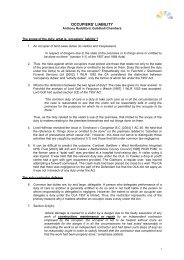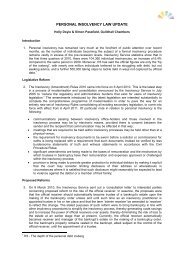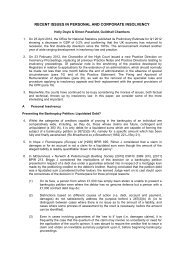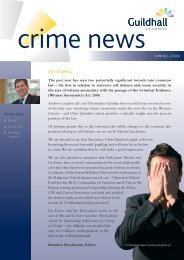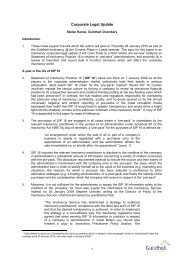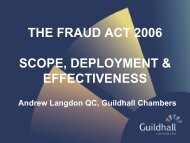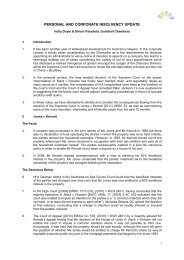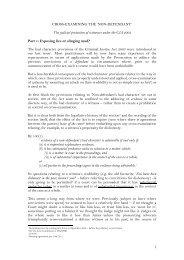Martha Maher & Catherine Burton (DLA Piper) - Guildhall Chambers
Martha Maher & Catherine Burton (DLA Piper) - Guildhall Chambers
Martha Maher & Catherine Burton (DLA Piper) - Guildhall Chambers
You also want an ePaper? Increase the reach of your titles
YUMPU automatically turns print PDFs into web optimized ePapers that Google loves.
CORPORATE INSOLVENCY LAW UPDATE<br />
Milestone cases shaping the future of Insolvency Law for 2009<br />
<strong>Catherine</strong> <strong>Burton</strong>, <strong>DLA</strong> <strong>Piper</strong><br />
<strong>Martha</strong> <strong>Maher</strong>, <strong>Guildhall</strong> <strong>Chambers</strong><br />
Introduction<br />
1. “Rushing past them at speeds undreamt of by the people who erected them, we pass these<br />
silent sentinels of earlier ages without much thought. We retain a fondness for these early<br />
markers by declaring any definitive waypoint as a “milestone…....” 1<br />
2. It is little wonder, in these topsy-turvey times, as the excesses of laissez-faire appear to have<br />
landed us in the most serious financial crisis since the Depression, that more Governmental<br />
Regulation should be on its way, not just in the shape of the Banking Act 2009, but in the form<br />
of another layer of reform of the insolvency legislation itself.<br />
3. The Budget Report on 22 April 2009 included a statement that the Insolvency Service would<br />
be consulting on the concept of super-priority funding and extending the moratorium<br />
provisions currently applicable to smaller companies to medium and large companies. These<br />
two reforms reflect some of the arguments put forward for a more US style “debtor in<br />
possession” type proceeding.<br />
4. In addition and to ensure that the recently introduced regulation of the pre-pack procedure is<br />
working to plan, the Insolvency Service is to publish a report in June 09 following the first six<br />
months of SIP 16 and plans to publish further follow up reports on an annual basis.<br />
5. None of this comes as a surprise, although a question for another forum to debate is whether<br />
additional regulation will do any good, given the propensity of financial professionals to<br />
innovate and expand, combined with the fact that such professionals are more financially<br />
motivated to act than the regulators are to respond.<br />
6. It is unsurprising that insolvency lawyers too are reaching back to first principles to steady<br />
their nerves with the rapidity of the collapse of the financial world and the huge uncertainty<br />
over its impact on the broader economy 2 . Who better to turn to than to Professor Goode’s<br />
Principles of Corporate Insolvency Law 3 for a statement of the ten fundamental principles<br />
underpinning insolvency legislation 4 .<br />
<br />
1 MilestonesWeb V: 1.1 Counting down the miles in a survey of milestones in Great Britain.<br />
2<br />
See Davies and Frith: “Clearing up the Mess” delivered at the R3 19 th Annual Conference on 19 February 2009<br />
3<br />
Third Edition<br />
4<br />
He uses liquidation as the paradigm. The principles are worth restating:<br />
“ First Principle: corporate insolvency law recognises rights accrued under the general law prior to liquidation. Second<br />
Principle: only the assets of the debtor company are available for its creditors. Third Principle: security interests and<br />
other real rights created prior to the insolvency proceeding are unaffected by the winding up. Fourth Principle: the<br />
liquidator takes the assets subject to all limitations and defences. Fifth Principle: the pursuit of personal rights against<br />
the company is converted into a right to prove for a dividend in the liquidation. Sixth Principle: on liquidation the<br />
company ceases to be the beneficial owner of its assets. Seventh Principle: no creditor has any interest in specie in<br />
the company’s assets or realisations. Eighth Principle: liquidation accelerates creditors’ rights to payment. Ninth<br />
Principle: unsecured creditors rank pari passu. Tenth Principle: members of a company are not as such liable for its<br />
debts.”<br />
1
7. Against this background we propose, in the time available to us to look briefly at five of the<br />
many significant cases which have been decided in the course of the last year.<br />
SIGNIFICANT RECENT CASES<br />
Stones and Rolls v Moore Stephens 2008 EWCA Civ 644, House of Lords hearing 10/2/09,<br />
awaiting judgement.<br />
8. This is an example of Professor Goode’s Fourth Principle in operation. The liquidator takes<br />
the assets subject to all limitations and defences. He is in no better position than the<br />
company itself: He takes the assets as they stand, warts and all. A liquidator takes subject to<br />
another party’s contractual rights under a contract with the company; and subject to another<br />
party’s equitable rights to impeach or qualify a transaction, which rights survive the company’s<br />
liquidation. Conversely the liquidator may by statute be able to assert defences which the<br />
company could not have raised prior to liquidation.<br />
9. The company in that case was a one man company owned and controlled by S who procured<br />
the company to defraud a bank. The proceeds were then diverted in favour of S and others<br />
who were party to the fraud. The bank sued the company and S in deceit and was awarded<br />
substantial damages against both. The company was unable to pay and went into liquidation.<br />
By its liquidators the company then issued proceedings for damages against its former<br />
auditors alleging negligent failure to detect the dishonest behaviour of S its sole directing<br />
mind and will.<br />
10. M denied negligence and applied to strike out the claim or for summary judgement contending<br />
that the company was seeking an indemnity against liabilities it had incurred by its own fraud<br />
and that such a claim was barred by the public policy principle ex turpi causa non oritur actio<br />
(“the Own Fraud rule”).The judge refused the application to strike out and the auditors<br />
appealed.<br />
11. In the CA two issues were identified, namely whether the Own Fraud rule (a) prevented the<br />
company from suing for recovery in respect of its own losses caused by the individual who<br />
was its directing mind and will in relation to the frauds – i.e. had the Company itself been a<br />
victim of the frauds which should not therefore have any knowledge of them attributed to it;<br />
and (b) in any event provided no defence to the auditors when the detection of dishonesty in<br />
the operation of the affairs of the company was the “very thing” that the auditors had been<br />
retained to do.<br />
12. The CA referred to the well known exception to the Own Fraud rule to the effect that an<br />
agent’s knowledge of a fraud is not imputed to his principle if the agent is acting in fraud of his<br />
principal and the matter of which he has notice is relevant to the fraud. The critical question<br />
was whether the Court should regard the company as the villain or the victim of the fraudulent<br />
activity of S: (a) if it was to be regarded as the victim of S’s dishonesty, his dishonesty would<br />
not be attributed to it such that it would be entitled to bring its claim. (b) If however it should<br />
properly be treated as itself carrying out the frauds (such that its claim to be a victim was<br />
based on no more than the liabilities it incurred as an inevitable consequence of those frauds)<br />
the Company must be regarded as the villain.<br />
13. The CA concluded that the Own Fraud rule applied on the grounds that the Company was not<br />
the target or the victim of S’s fraud but should be treated as the fraudster itself. It was the<br />
company which dealt with the banks and the principle of attribution required S’s dishonesty to<br />
2
e imputed to the company. It made no difference that the fraud was likely, when found out, to<br />
result in the incurring of liabilities by the company itself.<br />
14. The liquidator’s second argument was that the public policy behind the Own Fraud rule was<br />
not engaged where the prevention of fraud was the very thing the auditors were tasked to do.<br />
The CA concluded following a careful review of the authorities that once the Own Fraud rule<br />
applied, the Court was left with no discretion in the matter and the claim had to be stopped.<br />
The appeal was allowed and the claim against the auditors was struck out.<br />
15. The CA was unimpressed by the fact that the proceedings were pursued by independent<br />
liquidators for the benefit of the company’s creditors including the bank. Pre liquidation S<br />
could not credibly have caused the company to sue the former auditors for damages for<br />
failure to detect the frauds of S himself. As Mummery LJ observed:<br />
“116. What difference does the liquidation of the company make None. The fact that the<br />
company is in insolvent liquidation is irrelevant to the company’s cause of action against<br />
the firm. It is also irrelevant that, if successful, the claim could benefit the victim bank.The<br />
company in liquidation is asserting the same cause of action that was vested in it prior to<br />
liquidation. Liquidation of the company did not alter the existing cause of action or create<br />
a new cause of action. Prior to liquidation, the cause of action against the firm, could, if<br />
successful, benefit the fraudulent company. The same is true post-liquidation and is a<br />
reason for striking the claim out.”<br />
16. This is a manifestation of the principle that the company inherits the claim warts and all.<br />
17. The hearing of the liquidators’ appeal against the striking out in the House of Lords took place<br />
on the 10 February 2009 and judgement is expected before the seminar date.<br />
Sunberry Properties Limited v Innovate Logistics Ltd (in administration) 2008 EWCA Civ 1321<br />
18. Rent is not an administration expense.<br />
19. It is a provable debt.<br />
20. Payments falling due under a lease after the date of administration arise by virtue of a liability<br />
entered into before the commencement of the administration (the lease).<br />
21. Landlords are not automatically entitled to receive rent from tenants in administration.<br />
22. However, rent can be paid as if it were an administration expense.<br />
23. What does that mean In Sunberry v Innovate it meant that when Innovate went into<br />
administration and breached the terms of its lease by permitting the purchaser of its business<br />
into occupation, agreeing with the landlord to pay the landlord the rent reserved by the lease<br />
on a monthly basis (as opposed to quarterly in advance, as reserved by the lease) there was<br />
little the landlord could do about it.<br />
24. Innovate leased more than 8 acres of cold storage facilities from Sunberry at an annual rent<br />
of £1.2m. The premises were used to store frozen food pending distribution. In June 2008,<br />
shortly before the next quarter's rent fell due, it went into administration. The administrators<br />
completed a pre-packaged sale of the business to YHL, the UK's largest operators of cold<br />
3
storage facilities. The sale included the grant to YHL of a six month licence of the premises to<br />
YHL, on the basis that YHL would make payments equal to each month's passing rent. The<br />
licence would be determined on forfeiture of the lease by the landlord or upon earlier notice to<br />
terminate given by YHL or the company in administration.<br />
25. The granting of the licence was a clear breach of the terms of the lease. The Sunberry, as<br />
landlord, asked the administrators to terminate it. They refused to do so. Sunberry further<br />
sought the administrators' permission to commence proceedings against the company in<br />
administration for an injunction for the immediate termination of the licence. Again, the<br />
administrators refused.<br />
26. The landlord applied, successfully at first instance, for the court's permission to commence<br />
proceedings. However, when the matter came before the Court of Appeal, the decision was<br />
overturned.<br />
27. The Court of Appeal concluded that relevant evidence was not before the court at the first<br />
hearing and as a result, the judge had drawn incorrect inferences about the administrators'<br />
conduct. Furthermore, the judge at first instance had incorrectly concluded that the purpose<br />
of the administration had been achieved as soon as the sale to YHL had been concluded.<br />
Having done so, he was of the view that it would not be appropriate for him to undertake the<br />
balancing exercise expounded in Re Atlantic Computers which the court would usually apply<br />
when asked to consider whether to grant permission for a creditor to bring proceedings<br />
against a company in administration. That view was wrong.<br />
28. The purpose of this administration was to achieve a better result for the company's creditors<br />
as a whole than would be likely if the company were wound up without first being in<br />
administration. In seeking to give effect to the statutory purpose of administration, the court<br />
had to conduct a balancing exercise between the legitimate interests of the landlord and the<br />
legitimate interests of the other creditors of the company. In this case, although the<br />
company's business was sold immediately after the appointment of the administrators, in<br />
order for the purpose of this administration to be achieved, YHL would need to continue to<br />
use the premises for a short while, to ensure that customers received their goods and the<br />
insolvent business received the full benefit of its outstanding book debts.<br />
29. The court would need to compare the financial loss suffered by the landlord, if permission to<br />
commence proceedings were to be refused, with the loss suffered by the company's other<br />
creditors, if permission were to be granted.<br />
30. In this case, the landlord was notably not seeking permission to commence proceedings to<br />
forfeit the lease. It was clear that he did not want to recover possession of the premises.<br />
Sunberry's motive, it appears, was to seek to bring pressure to bear upon YHL to take a<br />
formal assignment of the lease and be committed to performing the tenant's covenants,<br />
including payment of the not insubstantial rent which, by then, probably exceeded market<br />
rates. Counsel for Sunberry argued that the administration moratorium was not being used to<br />
achieve a better result for the company's creditors as a whole but to benefit YHL and give it<br />
an unfair bargaining position in its discussions with the landlord.<br />
31. He submitted that Sunberry's intended proceedings would not deprive the administrators of<br />
possession of the property - the company in administration no longer required the property.<br />
The proceedings were directed against a third party, unlawful occupier and the ability of the<br />
company in administration to grant an unlawful licence to a third party was not "property of the<br />
company" which was protected by the statutory moratorium.<br />
4
32. However, whilst noting that the thrust of Sunberry's submissions referred to the detriment<br />
which the administrators actions had imposed upon the landlord's bargaining position with<br />
YHL the Court of Appeal concluded that the judge at first instance ought to have asked<br />
himself whether Sunberry had shown that it was inequitable to prevent it from commencing<br />
the proceedings for a mandatory injunction. Instead, he relied upon a range of inadequate<br />
reasons for not carrying out the Atlantic Computers balancing exercise.<br />
33. When the Court of Appeal now performed that exercise, it concluded that when weighing the<br />
loss to Sunberry compared with the loss to the company's creditors if the collection of book<br />
debts were to be impeded by Sunberry succeeding in its application, Sunberry's application<br />
should have been refused.<br />
34. In reaching its judgment, the Court noted that it had been accepted that Sunberry had no<br />
automatic right to be paid the contractual amounts during the occupation of the company in<br />
administration.<br />
"Sunberry does not have an absolute legal entitlement to be paid contractual rent and<br />
interest as an administration expense. On this point the court has a wide discretion<br />
exercisable according to the circumstances of the case."<br />
"In my judgment, Sunberry should be in no better position as regards rent and interest<br />
than it would have been in had it wished to forfeit the Lease. As regards rent falling due<br />
after the the administration order Sunberry is an unsecured creditor of the Company, and<br />
will benefit from the collection of the company's book debts.”<br />
35. The Court declined to order that the company in administration should pay anything more<br />
than the passing rent on a monthly basis, despite Sunberry's attempts to require payments in<br />
advance on the usual quarter days.<br />
Lehman Brothers International(Europe) (in Administration) (“LBIE”)<br />
2008 EWHC 2335; 2009 1 BCLC 161;<br />
36. If the “Golden Milestone” defined the centre of Imperial Rome, the Lehman insolvency defines<br />
the epicentre of the present economic collapse and the insolvency culture emanating therefrom.<br />
To gain a small insight into the complexity of the issues raised from an insolvency<br />
angle, a scan through the Joint Administrators’ Progress Report dated 14 April 2009 5 for the<br />
period from 15 September 2008 to 14 March 2009 is an interesting experience. 6<br />
37. From the outset of the administration, which of course happened with little notice to anybody<br />
concerned, there has been very considerable focus on the return of property to which third<br />
parties assert a proprietary claim 7 .<br />
38. This trust property included securities in the Company’s possession as at the 15 September<br />
2008 (called “Client Assets” in the Report) and cash balances managed by LBIE pursuant to<br />
the UK Financial services authority’s Client Money Rules at 15 September 2008 (“Client<br />
Money”) and jointly referred to as Trust Property.<br />
<br />
5<br />
On the PWC website<br />
6<br />
This applies not least to the Operating Model applied to the case: see Section 4 of the Progress Report<br />
7<br />
And illustrates Professor Goode’s Second and Third Principles in play.<br />
5
Proposed Scheme of Arrangement<br />
39. The objectives in relation to Trust Property are set out at Section 5 of the Report 8 which<br />
includes the identification, protection and return of Client Assets. There is in place a process 9<br />
for the return of assets under a “risk mitigating indemnity framework”, although it appears that<br />
over US$15 billion of the estimated $US26.1 billion of clients’ assets and over $2billion in<br />
Clients’ Money is still caught up in the administration. This process is dependent on bi-lateral<br />
negotiations with the individual clients, is proving to be lengthy and onerous and failing to<br />
bring finality between the administrators and the clients. One of the difficulties concerns the<br />
identification and determination of the pool of Claimants. There are competing claims, clients<br />
who are not playing ball in terms of providing adequate documentary evidence, and set-off<br />
issues all getting in the way of determining the pool of claimants . There are also valuation<br />
issues. In addition, some clients have not terminated their agreements with the company and<br />
the effects of termination are not legally clear. It is predicted therefore that the current bilateral<br />
approach to distributing the clients’ assets will take years.<br />
40. In addition the Administrators have shown themselves, not surprisingly given the sums of<br />
money involved, to be somewhat risk averse and do not want to return assets to a client<br />
unless they are certain that the client is unequivocally entitled to the assets. Recovery in the<br />
current climate and in any event may be difficult should it turn out that someone else has a<br />
better claim to a particular asset. As a result it is understood that the approach taken by the<br />
Administrators to a request for the return of assets typically includes:<br />
– a payment by the former client of at least $50,000 USD as a “contribution to<br />
the cost of dealing with the request on a priority basis<br />
– a retention of up to 1.25% to cover the costs of dealing with the assets and<br />
– an undertaking by the client to return the assets if the Administrators decide<br />
in good faith that the assets should not have been transferred together with<br />
security to support that obligation to return.<br />
41. To reduce the delay attendant on resolving the issues identified, and given the disinclination<br />
to sign up to the Administrators’ terms for bilateral return, the administrators have proposed<br />
that the return of clients’ assets is best facilitated through a Scheme of Arrangement pursuant<br />
to section 895 of the Companies Act 2006 10 and to that end an application was made to the<br />
Court on 16 March 2009 for approval to call creditors meetings. This is the first stage of a<br />
three stage process the other two stages being the calling of creditors/members meetings<br />
and the sanction by the Court of the scheme approved at the meetings. If the creditors voting<br />
on the scheme support it by majorities of 50% in number and 75% in value, and the court<br />
approves the scheme then it becomes binding on all creditors.<br />
42. However the scheme does not itself provide for the distribution of assets to clients but is<br />
designed principally to impose a bar date for submitting final claims. The Administrators say<br />
that it should provide the following benefits to clients:<br />
– achieving finality of the population of Client Assets claims allowing Client<br />
Assets to be distributed without the need for indemnity<br />
– ensuring no future claim arises against the company for assets distributed<br />
under the Scheme<br />
<br />
8<br />
Section 5.3 of the Report.<br />
9<br />
Following an application to the Court by the Administrators for directions on 7 October 2008.<br />
10<br />
Section 5.3.1 of the Progress Report<br />
6
– addressing the issue of competing claims and defines rules for dealing with<br />
asset shortfalls<br />
– providing finality of dealings with Client Assets claimants<br />
– allowing controlled termination of open positions and<br />
– applying a consistent set of rules for a number of issues including valuation<br />
methodology, allocation of costs and dispute resolution.<br />
43. The Administrators describe the nature and scope of the scheme as being “novel and<br />
ambitious” and that it is likely to require compromise by clients and the Company if it is to be<br />
effective. Although it is thought that the scale and complexity of this insolvency is unlikely to<br />
be seen again in this economic cycle, the approach being taken is instructive when faced with<br />
insolvencies involving substantial third party assets with significant obstacles in the way of<br />
straightforward return through bilateral negotiation or through seeking directions from the<br />
Court within the administration.<br />
Third Party Applications to Court<br />
44. There have been two applications to the Court by Third Parties keen to extract their assets<br />
from the administration. They both demonstrate that the courts will not readily give permission<br />
for the decisions of the administrators to be overridden and implicitly acknowledge that the<br />
business of an insolvency appointment calls for a high degree of specialist knowledge and<br />
experience and the Court will not intervene routinely.<br />
45. The first was RAB Capital plc and RAB Master Fund v LBIE 2008 EWHC 2335 (ch) in which<br />
Morgan J considered on 22 September 2008 whether a proprietary claim against the<br />
company under a prime brokerage agreement could be expedited following the<br />
administration . It submitted that bills held by the company for its Market (Master) Fund under<br />
a prime brokerage agreement represented the vast majority of the Fund’s assets and that the<br />
Fund would have to be put into suspense if its proprietary right was not established as a<br />
matter of urgency. The company submitted that the Applicant should not be allowed to<br />
circumvent the effects of the moratorium in this way as this would force the administrator to<br />
focus disproportionately on one particular counter-party and would potentially open the<br />
floodgates.<br />
46. The Judge said that the Claimants appeared to have a strong case on the merits and had his<br />
sympathies but he felt he had to refuse to have the claim dealt with as a matter of urgency<br />
because this was a case of administering an application for the return of assets and this was<br />
primarily a matter for the Administrators 11 . If he were to intervene the Court would be<br />
inundated with applications from others. In any event it appeared that the company had<br />
entered into a sub-custodian arrangement with another Lehman company in respect of the<br />
bills in question and all the company could do was to demand the return of the bills from that<br />
company.<br />
47. Following the Court’s order at a later hearing on the 7 October 2008 in which the<br />
Administrators sought directions from the Court regarding their approach to the return of third<br />
party property, the administrators set up a “hardship and prioritisation” committee to address<br />
special claims that meet specific criteria for accelerated return while ensuring that the<br />
overriding objective of treating all counterparties fairly is not prejudicial to the interests of any<br />
minority of the creditors.<br />
<br />
11<br />
The caselaw in this area is already substantial, and the principles formulated in Atlantic Computers Systems plc 1990 BCC<br />
439 are well known. For a sensible application of the principles governing the Court’s discretion see Re David Meek Access<br />
Limited, Re David Meek Plant Limited 1993 BCC 175.<br />
7
48. In Four Private Investment Funds v LBIE 2009 1 BCLC 161, involving similar facts, the Court<br />
refused an application for an order that the administrators provide additional information about<br />
securities that the Company held for the Applicants. The Court held that to make such an<br />
order would be an unjustified interference with the day to day running of the administration.<br />
49. This application was made inter alia under paragraph 74 of Schedule B1 IA 1986 which<br />
highlights the rights of creditors to scrutinise the conduct of the administrators under the<br />
“unfair harm” provisions. The Judge did not conclude that the cases should not be prioritised<br />
as hardship cases under the Court-approved protocol and was prepared to assume that harm<br />
was being caused and then considered what constituted “unfairness” within the paragraph.<br />
Given that there was no allegation of misconduct against the administrators and that they<br />
were operating in good faith in accordance with their statutory duty, it was difficult to see how<br />
their refusal to assign resources to dealing with specific enquiries of individual creditors could<br />
be said to be unfair. The Court referred to the directions hearing at which the strategy<br />
proposed by the administrators had been the subject of directions given by the Court and<br />
creditors had approved proposals. The administrators were to be allowed considerable<br />
latitude in performing their statutory duties directed at achieving the statutory objective.<br />
Oakland v Wellswood<br />
50. The Transfer of Undertakings (Protection of Employment) Regulations 2006 came into force<br />
on 6 April 2006. They superseded the earlier 1981 TUPE Regulations and constituted the<br />
UK's implementation of the EC Acquired Rights Directive, Council Directive 2001/23/EC. The<br />
Regulations sought, among other things, to mitigate the unintended but nevertheless<br />
potentially harmful effects of the 1981 TUPE Regulations on those working for insolvent<br />
employers. By providing for continuity of employment, the 1981 Regulations provided for<br />
purchasers of insolvent businesses to inherit all employees and all sums and liabilities due to<br />
them. This led to some prospective purchasers being deterred from proceeding with the<br />
purchase altogether and others, reducing the amount they were prepared to pay, thus<br />
reducing the amount available for distribution to the insolvent transferor's creditors.<br />
51. The 2006 Regulations provide for some liabilities due to the employees of solvent transferors<br />
not to transfer to the purchaser, but instead, to be met by the NIF. They also draw a<br />
distinction between:<br />
a. "relevant insolvency proceedings" being "proceedings which have been opened in<br />
relation to the transferor not with a view to the liquidation of the assets of the<br />
transferor and which are under the supervision of an insolvency practitioner"; and<br />
b. "bankruptcy of any analogous insolvency proceedings which have been<br />
instituted with a view to the liquidation of the assets of the transferor and are<br />
under the supervision of an insolvency practitioner".<br />
52. On 3 May 2006, Lord Hunt of Wirral rose to move the House of Lords to revoke the<br />
Regulations:<br />
"Insolvency practitioners are as anxious as anyone else that as many jobs as<br />
possible should be saved when an employer becomes insolvent. However, if the<br />
regulations are to have the desired effect, they must be drafted in clear, unambiguous<br />
language. Only then will those dealing with the insolvencies and those acquiring<br />
businesses subject to insolvency proceedings know where they stand and precisely<br />
how the provision of the regulations will affect transactions.<br />
8
Unfortunately, the regulations, as regards the insolvency provisions, failed to achieve<br />
that. This is because they are drafted in language that is so loose and imprecise it is<br />
not possible to discern with any clarity how they are supposed to work. Instead of<br />
bringing clarity, they bring confusion to new, unprecedented heights.<br />
My principal concerns are that these regulations, first, fail to specify the types of UK<br />
insolvency proceedings to which they are intended to apply; secondly, fail to make<br />
clear which liabilities will pass to a purchaser and which will not; and thirdly, impose<br />
unrealistic obligations on insolvency office holders with which it would be impossible<br />
for them to comply and with penalties that will ultimately fall on creditors. The<br />
regulations transpose the vague generic language of the directive without attempting<br />
to specify how it is to apply in the context of specific UK insolvency proceedings.<br />
Only expensive and time-consuming judicial interpretation will establish the<br />
circumstances in which they are intended to apply."<br />
53. Lord Hunt's motion failed by two votes. Lord Sainsbury of Turville, then the Parliamentary<br />
Under-Secretary of State for the DTI responded on behalf of the Government:<br />
"In our judgment, the generic descriptions of relevant insolvency proceedings in<br />
Regulations 8(6) and 8(7) are reasonably clear. In our view, there are unlikely to be<br />
significant problems.<br />
Let us look at the position of administrations, the main category of insolvency<br />
proceeding. Regulations 8 and 9 were drafted with the intention that where there was<br />
a transfer in a business or undertaking, and the transferor was in administration under<br />
the Insolvency Act 1986, employees engaged in that business should be transferred<br />
to the acquirer of the business or undertaking. … The key question is whether<br />
administration is analogous to bankruptcy proceedings and it would appear that it is<br />
not. The principal or main purpose of administration is not the realisation of the<br />
debtor's assets with a view to distribution among creditors. The statutory purpose to<br />
which administrators are obliged to have regard first is the rescue of the company.<br />
However, the interpretation of the regulations is ultimately a matter for the tribunal<br />
and the court".<br />
54. Perhaps the only surprising aspect of the Employment Appeal Tribunal's decision in Oakwood<br />
and Wellswood, formally handed down on 9 January 2009 (although unintentionally released<br />
without authority in December 2008) is that it took so long for the issue to be brought before a<br />
tribunal.<br />
55. Mr Oakland was a director and 50% shareholder in a wholesaler of fruit and vegetable. When<br />
the business ran into financial difficulties, with the assistance of insolvency practitioners, a<br />
sale of the company's assets, including the unit from which it traded, fridges, vans and five of<br />
the seven employees (including Mr Oakland) was agreed with the company's main creditor.<br />
A pre-packaged sale to NewCo took place on the date of the administrators' appointment.<br />
The administrators' proposals explained to creditors that they had concluded that it would not<br />
be possible to rescue the company as a going concern and that they would therefore be<br />
exercising their powers with the objective of achieving a better result for creditors than would<br />
be likely if the company were wound up. The administrators explained that as the company<br />
was losing money, further trading would have diminished returns to creditors. They did not<br />
therefore consider it appropriate for the business to be traded in administration in order that it<br />
could be further exposed to the market.<br />
9
56. Mr Oakland was dismissed less than a year after the transfer to NewCo. He complained to a<br />
tribunal that he had been unfairly dismissed. Among its defences, NewCo sought to argue<br />
that Mr Oakland did not have the necessary continuity of employment to be able to bring a<br />
claim of unfair dismissal. NewCo contended that the Regulations did not apply to the transfer<br />
to NewCo and consequently any period of employment which Mr Oakland might have had<br />
with NewCo was irrelevant.<br />
57. This argument succeeded before the first Employment Tribunal and also in the Employment<br />
Appeal Tribunal.<br />
58. Judge Peter Clark concluded that where joint administrators continue to trade the business<br />
with a view to its sale as a going concern, any relevant transfer in those circumstances will<br />
attract TUPE protection for employees. However, where, as in this case, the administrators<br />
realised that it would not be possible to trade the business and sold the company's assets<br />
immediately after their appointment, in his view, the appointment of the administrators "was<br />
with a view to the eventual liquidation of the assets of Oldco, by way of a CVL."<br />
59. The learned judge considered that his decision accorded with the rescue culture whereby a<br />
purchaser is not put off the proposed sale by the effects of TUPE, pointing out that in this<br />
case some jobs were preserved and the creditors benefited from the best available outcome.<br />
60. An application for permission to appeal to the Court of Appeal has been heard and at the time<br />
of writing, awaited. It seems likely that permission will be granted. As reflected by the<br />
comments of Lord Sainsbury above, those involved in the years of consultation before the<br />
Regulations were introduced are of little doubt that the spirit of TUPE dictates that a transfer<br />
of a business effected by administrators should attract the protection afforded by TUPE for<br />
the employees of the business. However the Regulations were consulted upon and<br />
introduced against the backdrop of a thriving UK economy. Unemployment has risen<br />
considerably since Judge Peter Clark handed down his judgment in January this year. In<br />
early May 2006 the European Commission predicted that unemployment will rise to 11% in<br />
2010.<br />
61. News of the EAT decision spread like wild fire around the insolvency market. Within days of<br />
the unauthorised version of the judgment inadvertently being released on BAILII, prospective<br />
purchasers of insolvent businesses were seeking to remove provisions in sale agreements<br />
intended to ensure that notwithstanding the doubt concerning the meaning, effect and<br />
application of the Regulations, they would nevertheless treat the sale as if TUPE would apply.<br />
62. The market now awaits the outcome of an appeal (assuming that permission will be given). It<br />
seems undeniable that in these harsh economic times, somewhat ironically, more jobs are<br />
likely to be saved if a final decision is reached to the effect that the Regulations would not<br />
apply to a pre-pack sale effected immediately after the administrators' appointment, than<br />
would be the case if the decision is overturned.<br />
63. There is, of course, scope for the CA decision to be appealed further.<br />
64. In the meantime, practitioners should take care to protect themselves in a number of ways:<br />
a. Most firms provide employees with a letter to explain the effect of the administration<br />
and business sale. They should take care to ensure that such letters could not be<br />
considered to be providing advice or making representations on the effect of the<br />
transfer on the employees' contract of employment. Such letters should prudently<br />
10
advise the employees that the Government's Insolvency Service guidance has stated<br />
that the Regulations will apply to the transfer. The letter should proceed to state that<br />
the administrators and purchaser will treat the transfer on this basis but make no<br />
representation and express no view as to whether or not it is correct.<br />
b. The Regulations require "employee liability information" to be provided to the<br />
purchaser not less than 14 days before the transfer, including the identity and age of<br />
the employee and information regarding disciplinary or grievance procedures taken<br />
with the previous two years. Where the transferor company in administration fails to<br />
provide the information, the purchaser is entitled to claim £500 per employee<br />
transferred. Despite repeated representations made by R3 to the DTI during the<br />
consultation period, it was not prepared to exclude insolvent companies from these<br />
provisions. The fact that nobody has been able to ascertain, with certainty, whether<br />
the Regulations apply to any particular sale effected by insolvency practitioners<br />
renders the requirement to provide employee information hazardous. It would<br />
amount to a breach of the data protection legislation for insolvency practitioners to<br />
provide such information without being statutorily obliged to do so. In practice, many<br />
practitioners do not, in any event, provide the required employee liability information<br />
and seek to circumvent the prohibition on contracting out of the Regulations by<br />
requiring that the purchaser agrees to indemnify the insolvent transferor company<br />
and the practitioner for any failure to comply with the employee liability information<br />
requirements - in effect ensuring that the purchaser indemnifies the IP for any claim<br />
which the purchaser may himself bring against the IP.<br />
c. The definition of "employee" in any sale agreement should be carefully checked.<br />
d. It is generally considered that where TUPE does not apply, the transfer of a business<br />
will automatically terminate contracts of employment. It was to prevent this hardship<br />
that TUPE was introduced in the first place. Provided this is correct, practitioners<br />
need not be concerned of the risk of Paramount claims for failing to take positive<br />
steps to terminate employee contracts.<br />
The “Insolvency Remote” culture<br />
Re Sigma Finance Corporation Limited 2008 EWCA Civ 1303<br />
Re Golden Key Limited in Receivership 2009 EWHC 148 (ch)<br />
65. SIVs are 12 investment companies that buy highly rated debt securities and fund themselves<br />
by the issue of senior debt and capital to financial institutions. Security over their asset<br />
portfolios is granted by a deed of charge to a security trustee appointed under a security trust<br />
deed for the benefit of specific categories of secured creditors. All of them have a clause<br />
dealing with priority of payments if they become insolvent, a so called waterfall which would<br />
run, typically:<br />
(1) the costs and expenses of receivership<br />
(2) the senior creditors<br />
(3) the junior and senior subordinated creditors<br />
(4) other costs<br />
(5) the company.<br />
<br />
12<br />
Most are no longer going concerns and/or are in some form of insolvency procedure<br />
11
66. The triggers leading up to enforcement of rights may differ but usually they will include: the<br />
failure to pay, insolvency, a downgrading of its investments or a fall in the required levels of<br />
capital or liquidity.<br />
67. There has been quite a bit of case law generated over the last 18 months relating to the<br />
construction of the security trust deed, in particular as to the application of realisations coming<br />
into the hands of the security trustee or receivers appointed to realise the secured assets on<br />
its behalf. The most common question to arise has been whether senior creditors should be<br />
paid on a “pay as you go” basis or a “pari passu” basis. Of course the “pari passu” rule has<br />
been the rule which every insolvency practitioner has been brought up to respect and it<br />
underpins the whole ethos of conventional insolvency law. However Professor Goode makes<br />
the valid point 13 that this principle only applies to the free assets of the company and therefore<br />
not to property held on trust or subject to the huge range of security interests now available,<br />
not to mention retention of title and other real rights and equities.<br />
68. The documentation surrounding these structures has been drafted in such a way that the<br />
company’s creditors have agreed, by way of various different contractual mechanisms, only to<br />
look to the assets secured under the documents they have signed up to for repayment of their<br />
claims, and then only within the terms of the limited recourse provisions set out in the<br />
documentation governing the company’s operations. In that sense it is said to be “insolvency<br />
remote”.<br />
69. The important point to be emphasised by the Courts following a number of decisions 14<br />
agonising on the construction of these documents, is that all of the creditors by virtue of the<br />
provisions in the contractual documentation, have agreed to limit their right of recourse<br />
against the company and its assets to their entitlement under the documentation and not to<br />
pursue any insolvency procedures against the company. Therefore the usual rights of the<br />
unsatisfied creditor to initiate insolvency proceedings are ousted in favour of the rights<br />
whether sounding in contract or trust provided by the documentation. 15 Henderson J in<br />
Golden Key, which is the most recent case in this area, commented that no party in that case<br />
had submitted that there was any objection from a public policy viewpoint in investors<br />
agreeing to make their investment upon such a basis. However the Courts have concluded<br />
that the consequence of the arrangement reached is that the degree to which assistance can<br />
be obtained from analogies with the general law of insolvency is limited. According to<br />
Henderson J:<br />
“Since the parties have expressly agreed to oust the general law of insolvency, one<br />
should not too readily assume that the parties intended their rights to be governed or<br />
influenced by insolvency concepts, such as pari passu distribution, unless the<br />
documentation so provides.” 16<br />
70. Sigma Finance 17 raised the short question of construction of a provision in a security trust<br />
deed, which came into force after the happening of various specified events of default, and<br />
the passing of a resolution by holders of the relevant instruments to enforce the security.<br />
When that happened the security trustee had to use its reasonable endeavours to establish<br />
various pools of assets before the end of the “Realisation period” and for that purpose was<br />
obliged to realise, dispose of or otherwise deal with the assets in such a manner as, in its<br />
<br />
13<br />
Surprisingly not picked up in the cases discussed below.<br />
14<br />
Cheyne Finance plc No 1 2008 1 BCLC 732; Cheyne Finance No 2 2008 1 BCLC 741; Cheyne Finance No 3 2008 EWHC<br />
648 (ch); Re Whistlejacket Capital Ltd 2008 EWHC 463 (ch) ; Re Whistlejacket Capital Ltd 2008 EWCA 575 ; Bank of NY v<br />
Montana Board of Investments 2008 EWHC 1594. Re Sigma Finance Corp (below); Re Golden Key in Receivership (below).<br />
15<br />
See Henderson J in Re Golden Key Limited in Receivership 2009 EWHC 148(ch) at para 48<br />
16<br />
Golden Key supra at para 48.<br />
17<br />
The largest SIV to go into a formal insolvency procedure.<br />
12
absolute discretion, it deemed appropriate. The relevant clause (clause 7.6) then concluded<br />
as follows:<br />
“During the realisation Period the Security Trustee shall so far as possible discharge on<br />
the due dates therefore any Short Term Liabilities falling due for payment during such<br />
period, using cash or other realisable or maturing Assets of the Issuer”.<br />
71. The case turned on the meaning to be attributed to the words “as far as possible”. Upholding<br />
the decision of the judge at first instance, the CA decided by a majority (Lloyd LJ and Rimer<br />
LJ with Lord Neuberger dissenting) that the Security Trustee was obliged to continue paying<br />
maturing notes in full during the realisation period on a pay as you go basis , until it had no<br />
more assets with which to pay them.<br />
72. Like all cases in this category, Sigma turned on the interpretation of the bargain actually made<br />
between the parties. The fact that the CA were divided shows how difficult these questions<br />
may be. At paragraph 92 Rimer LJ said:<br />
“I think it likely that many lawyers may be instinctively surprised at such a conclusion,<br />
since the culture with which they will be familiar is one ordinarily providing for a pari<br />
passu sharing in an insolvency. The notion of first come first served, or pay as you go, is<br />
alien to that culture and so cannot be right. I too had an instinctive initial sympathy with<br />
the case advanced by [the creditors contending for the pari passu construction] since<br />
when the available pot is too small to pay everyone in full, a pari passu distribution has<br />
an obvious appeal. But we are not here concerned to apply any conventional insolvency<br />
regime. The STD [Security Trust Deed] reflects a commercial bargain made between or<br />
on behalf of the interested parties and our task is to interpret what that bargain was. It<br />
seems to be apparent that the STD foresaw the possibility that any enforcement might be<br />
either a solvent or an insolvent one as regards secured creditors. It is however<br />
improbable that it foresaw the possibility of the extraordinary, probably unprecedented,<br />
market events that have recently unfolded. In those extraordinary events Party A’s<br />
successful argument can on one view perhaps be regarded as having achieved an unfair<br />
result. But any such assessment necessarily assumes that the parties had made some<br />
different bargain which is not being respected. This litigation is concerned with<br />
ascertaining the bargain they in fact made. I have expressed my view as to what it was,<br />
and the court’s duty is to give effect to it. It is not the Court’s function to re-write it.”<br />
73. One of the main consequences of these decisions for domestic corporate insolvency is that<br />
issues similar to those dealt with in Sigma and Golden Key are likely to arise in the context of<br />
companies which are not SIVs. Many large companies have granted layers of security<br />
governed by similar provisions and their debts are subject to similar default and acceleration<br />
clauses. The SIV cases will be instructive when the factions of secured creditors of such<br />
companies contest payment of the fruits of assets realised by or on behalf of their security<br />
trustee.<br />
<strong>Catherine</strong> <strong>Burton</strong>, <strong>DLA</strong> <strong>Piper</strong><br />
<strong>Martha</strong> <strong>Maher</strong>, <strong>Guildhall</strong> <strong>Chambers</strong><br />
May 2009<br />
13




